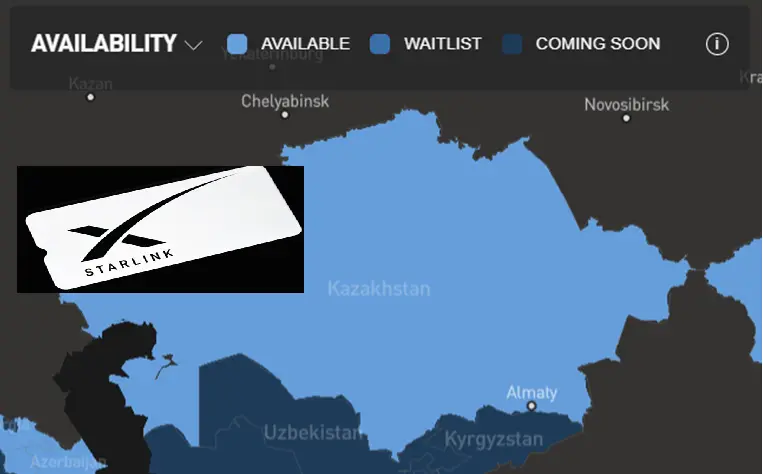
Kazakhstan has officially joined the Starlink constellation
Starlink Kazakhstan Launch – In a bold stride toward digital transformation, Kazakhstan has officially joined the Starlink constellation. After a year of regulatory negotiations and technical groundwork, Elon Musk’s satellite internet venture has gone live in the Central Asian nation, promising high-speed connectivity across its vast and often underserved terrain. The launch marks a significant milestone not only for Kazakhstan’s digital infrastructure but also for the broader global conversation around equitable internet access.
While Kazakh citizens celebrate the arrival of low-latency internet in remote regions, users in other parts of the world, still waiting for Starlink’s rollout, voice growing frustration. The launch in Kazakhstan is more than a regional tech story; it’s a snapshot of the shifting dynamics in global connectivity, digital diplomacy, and the race to bridge the digital divide.
Kazakhstan’s Digital Leap: Why Starlink Matters Here
Kazakhstan, the world’s ninth-largest country by land area, has long grappled with the challenge of connecting its dispersed population. From the bustling streets of Almaty to the remote villages of the steppes, internet access has been uneven, often slow, and prohibitively expensive in rural zones.
Starlink’s arrival changes the game:
- Geographic Advantage: Satellite internet bypasses the need for extensive ground infrastructure. In Kazakhstan, where laying fiber across vast plains and mountainous regions is costly and complex, Starlink’s low-Earth orbit satellites offer a practical solution.
- Government Collaboration: The launch follows a year of close coordination between SpaceX and Kazakh regulatory bodies. This included spectrum allocation, licensing, and compliance with national cybersecurity standards.
- Economic Impact: Improved connectivity is expected to boost e-commerce, education, telemedicine, and digital entrepreneurship. It’s a step toward diversifying Kazakhstan’s economy beyond oil and minerals.
- Social Inclusion: For nomadic communities and isolated settlements, Starlink offers a lifeline to the digital world, access to information, services, and opportunities previously out of reach.
Kazakhstan’s embrace of Starlink signals its ambition to be a regional leader in digital innovation, and it sets a precedent for other countries with similar geographic and infrastructural challenges.
Starlink Global Expansion: Progress, Politics, and Pushback
Starlink’s mission to provide global internet coverage is ambitious, and its rollout has been both celebrated and contested. With over 6000 satellites already in orbit, the service is available in more than 70 countries but not without hurdles.
- Regulatory Bottlenecks: Each country has its own telecom laws, spectrum policies, and national security concerns. Negotiating these frameworks takes time, and delays are common.
- Geopolitical Sensitivities: In some regions, governments are wary of foreign-controlled internet infrastructure. Concerns about surveillance, data sovereignty, and digital colonialism have slowed adoption.
- User Frustration: While Kazakhstan celebrates, users in countries like India, Egypt, and parts of Africa express impatience. Many signed up for Starlink’s beta years ago and are still waiting for service.
- Infrastructure vs. Access: Even where Starlink is technically available, affordability remains a barrier. The cost of hardware and monthly fees can be prohibitive for low-income users.
Despite these challenges, Starlink continues to expand, driven by growing demand for reliable internet in underserved areas. Its success in Kazakhstan may serve as a blueprint for future launches in similarly complex markets.
The Satellite Internet Revolution: Opportunities and Challenges
Starlink is part of a broader satellite internet revolution, with competitors like Amazon’s Project Kuiper and OneWeb also racing to blanket the globe with connectivity. This new frontier offers transformative potential—but also raises critical questions.
- Digital Equity: Satellite internet can democratize access, but only if pricing models are inclusive. Bridging the digital divide means addressing both availability and affordability.
- Environmental Concerns: The proliferation of satellites increases the risk of space debris and orbital congestion. Long-term sustainability of satellite networks is a growing concern among scientists.
- Cybersecurity and Privacy: As satellite internet becomes mainstream, ensuring robust encryption and data protection is vital. Cross-border data flows complicate regulatory oversight.
- Cultural Impact: In remote regions, internet access can reshape education, media consumption, and social norms. While empowering, it also introduces new cultural dynamics and potential dependencies.
Kazakhstan’s experience will be closely watched, not just for technical performance, but for how satellite internet reshapes its society, economy, and governance.
Starlink Kazakhstan Launch: The Road to Universal Connectivity
Starlink’s launch in Kazakhstan is a milestone, but the journey toward universal connectivity is far from over. The global digital divide remains stark, and satellite internet is only one piece of the puzzle.
- Policy Innovation: Governments must craft forward-looking policies that balance innovation with regulation. Public-private partnerships can accelerate deployment while safeguarding national interests.
- Localized Solutions: Satellite internet should complement, not replace, terrestrial networks. Hybrid models, combining fiber, mobile, and satellite offer the best path to resilient infrastructure.
- Community Engagement: Success depends on local buy-in. Training, awareness, and digital literacy programs are essential to ensure meaningful use of connectivity.
- Global Collaboration: Bridging the digital divide is a shared challenge. International cooperation, funding mechanisms, and technology sharing can help extend access to the most marginalized communities.
Kazakhstan’s Starlink moment is a glimpse into the future, a world where geography no longer dictates opportunity, and where the sky itself becomes a gateway to progress.
Final Thoughts
From the steppes of Central Asia to the satellites orbiting above, the launch of Starlink in Kazakhstan is a powerful symbol of technological possibility. It’s a story of ambition, collaboration, and the enduring human desire to connect. As more nations look to the stars for solutions, the challenge will be to ensure that this connectivity uplifts, empowers, and includes rather than divides.
The digital frontier is expanding. The question now is: who gets to cross it next?
Starlink India Launch: Elon Musk’s Satellite Internet Set to Revolutionize Connectivity